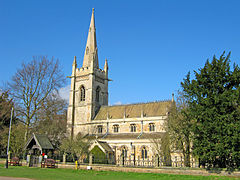Human settlement in England
| Perlethorpe | |
|---|---|
 St John’s Church, Perlethorpe. St John’s Church, Perlethorpe. | |
 | |
| OS grid reference | SK648711 |
| Civil parish | |
| District | |
| Shire county | |
| Region | |
| Country | England |
| Sovereign state | United Kingdom |
| Post town | NEWARK |
| Postcode district | NG22 |
| Dialling code | 01623 |
| Police | Nottinghamshire |
| Fire | Nottinghamshire |
| Ambulance | East Midlands |
| UK Parliament | |
| |
Perlethorpe is a small village and former civil parish, now in the parish of Perlethorpe cum Budby, in the Newark and Sherwood district, in the county of Nottinghamshire, England. Nearby is Thoresby Hall, the former home of the Earl Manvers. In 1891 the parish had a population of 139.
Etymology
Perlethorpe is from Old Norse thorp/þrop "village", a place-name element common in Nottinghamshire, and nearby Lincolnshire. The first element of the name, perle is unknown, and toponymists can only speculate as to its origin. However, there are three particularly popular suggestions. The first is "rush of water" from the Old English and Middle English perle. The second is that it's a deviation from the possible original name Palethorpe, pale meaning "area enclosed by a boundary". Lastly it may have been a deviation from Peverelthorpe as William Peverel was a powerful landowner in the area during the reign of Henry II.
Geography and history
The village itself is located about a quarter of a mile west of the A614, about half a mile north of Ollerton and 10 miles north east of Mansfield. The River Meden runs nearby. The village contains a large green, a village hall, a large church (of Saint John the Evangelist) and a village shop. There was once a primary school in the village but that has since been closed down and the building used as an Environmental Education Centre to teach children from many schools about the countryside.
Although the village has a much longer history, the oldest buildings which now remain date back only as far as the middle of the 19th century. The church of Saint John was built in 1876 and became the parish church in 1877. The half-timbered Almshouses near the church were built by Walter Owen Hickson c. 1890. Perhaps the most striking buildings are the "Redbrick" buildings, dating from the 1950s which are found clustered around the village green. These, like many of the older dwellings, were used exclusively for workers at Thoresby Hall when they were first built. Roman coins were found in the village in the 2000s. The parish records date from 1529, some 10 years before it became law for them to be kept, making them some of the oldest in the country.
Perlethorpe was formerly a township and chapelry in the parish of Edwinstowe, from 1866 Perlethorpe was a civil parish in its own right, on 1 October 1899 the parish was abolished to form Perlethorpe cum Budby.
See also
References
- "Population statistics Perlethorpe Ch/CP through time". A Vision of Britain through Time. Retrieved 22 March 2023.
- ^ "Perlethorpe – History". Southwell & Nottingham Church History Project. Retrieved 10 June 2008.
- Pevsner, Nikolaus (1979). The Buildings of England: Nottinghamshire. Harmondsworth, Middlesex: Penguin.
- Portable Antiquities Scheme. "Perlethorpe cum Budby, Nottinghamshire, England: Post medieval trader's token, Derby". Archived from the original on 28 September 2007. Retrieved 10 June 2008.
- "History of Perlethorpe, in Newark and Sherwood and Nottinghamshire". A Vision of Britain through Time. Retrieved 22 March 2023.
- "Relationships and changes Perlethorpe Ch/CP through time". A Vision of Britain through Time. Retrieved 22 March 2023.
External links
![]() Media related to Perlethorpe at Wikimedia Commons
Media related to Perlethorpe at Wikimedia Commons